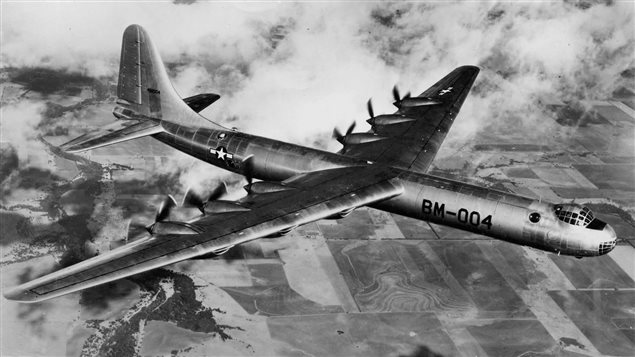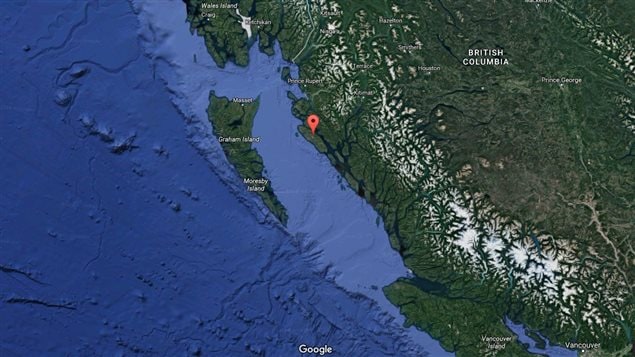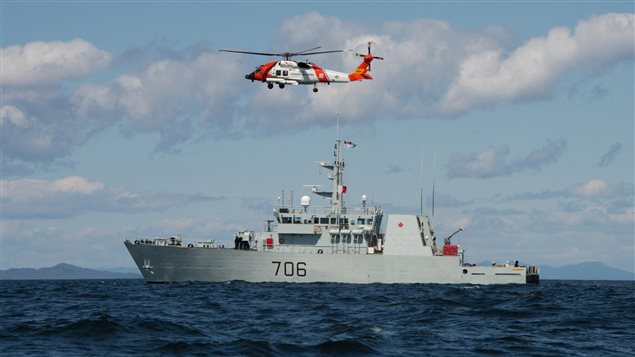The Royal Canadian Navy is preparing to dispatch one of its warships later this month to investigate a mysterious object found by an intrepid diver in the waters off the coast of British Columbia.
Sean Smyrichinsky found the mystery object during a recent diving trip near Banks Island.
“I got a little far from my boat and I found something that I’d never ever seen before,” he said in an interview with the CBC’s Daybreak North program. “It resembled, like, a bagel cut in half, and then around the bagel these balls all cut into it, molded into it… It was the strangest thing that I had ever seen.”
(click to listen to a clip of Sean Smyrchinsky’s interview with the CBC’s Daybreak North program)
ListenSmyrichinsky’s first impression was that he must have come across something completely alien.
“I came out from the dive and I came up and I started telling my crew ‘my god, I found a UFO!'”
However, it turned out there might be a more earthly if no less sinister explanation for Smyrichinsky’s find – a long lost U.S. nuclear bomb.
A relic of Cold War

When Smyrichinsky started asking around from more veteran divers about possible origins of the strange object, he was told the story of Convair B-36B, a US Air Force bomber that crashed off B.C.’s north coast in 1950.
When the boat he was on finally came into a cell reception area, Smyrichinsky was finally able to do some online sleuthing of his own. He found out that the bomber and its crew of 17 people was carrying a nuclear bomb, a Mark IV, which was never found after the plane crashed.
As soon as he looked up Google images of Mark IV the resemblance with the object he saw at the bottom of the ocean was obvious, Smyrichinsky said.

“It was a piece that looked very much like what I saw, a big circle with these balls,” Smyrichinsky said. “I had no idea that a nuclear bomb contained all these big balls, bigger than basketballs.”
The Convair B-36B had crashed about 50 miles south of where he found the object, Smyrichinsky said.
“That’s what really set me off,” Smyrichinsky said. “Wow! I’m right in the right area, and it looks like it could be a piece of that thing, there is nothing else like that. What else could it possibly be? I was thinking a UFO, but probably not a UFO, right?”
A dummy bomb?

Lt. (N) Greg Menzies, a spokesman for the Royal Canadian Navy, said Canadian military experts are working in close collaboration with their U.S. colleagues to determine what the object is.
(click to listen to the full interview with Lt. (N) Greg Menzies)
ListenThe navy plans to dispatch HMCS Yellowknife, a coastal defence vessel, around the third week of November to conduct an investigation, Menzies said. The navy will take Smyrichinsky on board HMCS Yellowknife with them so he can pinpoint the location of his find.
The navy will deploy a small remotely operated vehicle (ROV) that can take still and video images of objects on the ocean floor, Menzies said.
“What we will also do we will also embark a small team from Fleet Diving Unit Pacific who are very well versed in operating this kind of equipment and they will provide explosive ordinance oversight in determining what the object is when they do in fact find it,” Menzies told RCI.
Based on information provided by the U.S. military the object is most likely from the 1950 crash of the B-36B bomber, but records indicate the lost bomb was a dummy capsule and so there is little risk of the object being a nuclear weapon and posing an environmental hazard, Menzies said.
“At this point I can tell you that there is no nuclear material on this particular item and we have been confirmed that it’s actually a dummy capsule,” Menzies said.
With files from CBC News







For reasons beyond our control, and for an undetermined period of time, our comment section is now closed. However, our social networks remain open to your contributions.